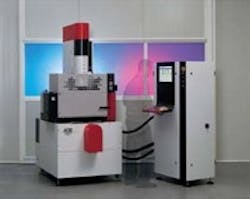Sinker EDM side-by-side
More shops are opting for sinker EDMs with longer table travels than those of the often considered "standard-size" of 12 in. by 8 in. (X/Y) for two reasons. first, shops see the larger machines as offering increased production. the second reason is more strategic: Much of the work typically done on standard size machines has moved offshore, so shops are setting their sights on jobs involving larger workpieces.
Sinker EDMs with longer table travels help to increase production because they give shops room to load multiple jobs for extended, untended operation both overnight and on weekends. also, the larger eDMs provide plenty of room for automation, such as a robotic arm used to load and unload work pallets.
Sinker EDM builders said shops that are considering sinker eDMs with longer table travels have to know about seven key machine aspects.
1: The way that the machine changes electrodes. 2: The power supply. 3: The C-axis capability. 4: The machine's control and programming, especially as automation and report generation are concerned. 5: The way the machine positions (glass scales or encoders). 6: If the machine uses dielectric fluid additives, and whether it can quickly switch between using additives, to not using them and back again. 7: Whether the machine's dielectric tank is fixed or rises and falls.
The above chart addresses these seven machine aspects for brands of sinker EDMs that range in size (X/Y) from 14 in. by 10 in. to 25 in. by 17 in.
